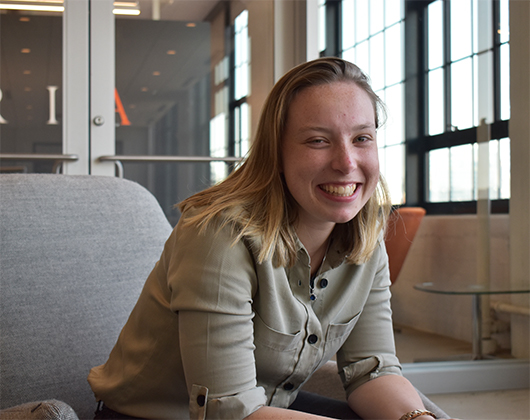Date
July 22, 2019

Alanna Brunton
What is the best advice you received?
Probably the best advice I received was to be patient with the design programs, etc. that are used in the office and not to be deflated when you hit a standstill after having great success. It is easy to get comfortable and overestimate your abilities, and then when something doesn’t work, it’s frustrating. If you just take a moment though, you realize people have run into the same problem before – TRIA has a good atmosphere where no one is unapproachable. Nothing is insurmountable, and help is always available; you just have to be willing to ask.
What is your favorite part of the job?
I am pleased that the scope of work available to me has been wide. My time here wasn’t spent making copies or getting coffee; I was included when we were talking to project managers, or the Director of Operations about drawings, deliverables, and how the project was to move forward. I was given authority and responsibility over my tasks and trusted to get the job done without having someone hover over me. I participated in an onsite survey to measure equipment and spaces, but TRIA also organized an educational outing, where we went to the site of a refurbished lab space. It helped put projects into perspective and made the theoretical practical.
What is a notable challenge you faced?
Revit. TRIA has far surpassed any class, module, or lecture series I have ever had with regards to Revit/BIM – to be honest, I was not particularly fond of the program initially. Not long after I arrived at TRIA, however, my least favorite design software actually became my preferred. I learned to be more methodical in my application, and to see the program as a 3D spreadsheet. Using Revit everyday and constantly learning more about it will be invaluable to my architectural career going forward.
Has working at TRIA changed your opinion of your field of study? How?
In college, architecture was theoretical, almost poetical. We learned about famous architects, people who changed the game. You had the timeline from primitive architectural form to now; it all seemed a bit abstract at times. You were free to do what you wanted with a design – if the professor liked it, you were golden. But working here, the client becomes the priority: you can create something you think is great, but if the client doesn’t like it, then it doesn’t matter. While in college, you could easily work as an individual, but working here has prioritized group cohesion. We work with all the different groups of people who contribute to a building, and TRIA has taught me that there are many facets of architecture that can be extremely specialized. It has opened a whole new avenue regarding lab design and the biotech industry for me. TRIA reinforces that lab design isn’t generic, one type does not suit all.
What do you wish you had more exposure to during your time here?
I would have liked to sit in on a design team meeting for a larger project had my time here been longer. Often, I would receive documents that had already been revised, and just needed to be built. I would have liked to sit in on conversations to understand the design decisions in more depth: how do you get the end product, what is prioritized, etc. Nevertheless, I’ve gotten more exposure than I had initially anticipated, so I am delighted with that.
What is your fondest TRIA related memory?
Some of the fondest memories were the TRIA outings. I really admire their focus on maintaining a good work-life balance. The Commodore Dodgeball Competition is one I will not be forgetting anytime soon. It happened 3 days after I joined TRIA, and everyone was incredibly welcoming. It made me feel involved, and like I was part of the team. The event allowed me to see a bunch of other construction, architectural. and engineering offices in Boston; and I saw a lot of interns my age, who shared my field of study. I didn’t realize there were so many of us – it is comforting to know I wasn’t the only one facing the questions and challenges I have since come across.


